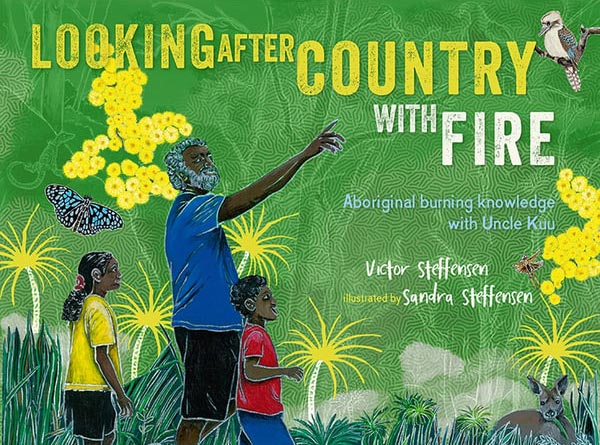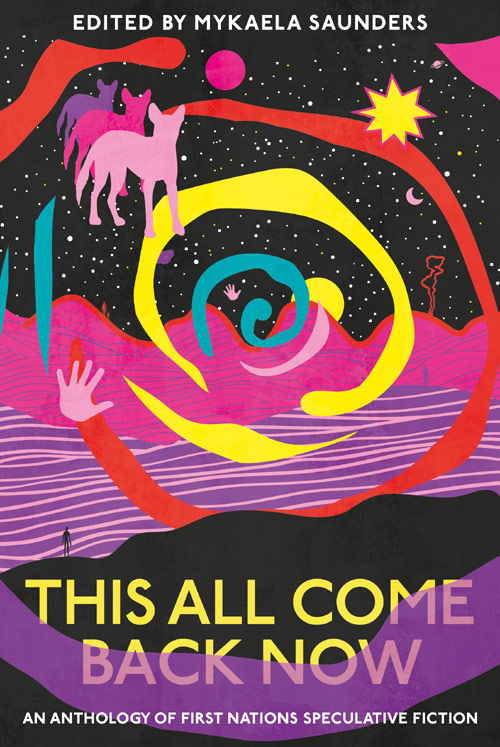Showing all posts tagged: Indigenous literature
Looking After Country With Fire wins 2023 Karajira Award
8 September 2023

Book cover of Looking After Country With Fire, by Victor Steffensen.
Looking After Country With Fire, published by Hardie Grant in 2022, written by Indigenous Australian writer and filmmaker Victor Steffensen, and illustrated by Far North Queensland based visual arts teacher Sandra Steffensen, has won the 2023 Karajira Award for Children’s Literature.
Presented by the Wilderness Society, the Karajira Award celebrates excellence in children’s literature by Aboriginal or Torres Strait Island authors and/or illustrators, who honour connection to Country and tell stories exploring land, community, culture, and language.
Looking After Country With Fire explores methods and systems of fire management used by Indigenous Australians, over thousands of years, to manage, and regenerate the land:
Mother Nature has a language. If we listen, and read the signs in the land, we can understand it. For thousands of years, First Nations people have listened and responded to the land and made friends with fire, using this knowledge to encourage plants and seeds to flourish, and creating beautiful places for both animals and people to live.
RELATED CONTENT
Australian literature, Indigenous literature, literary awards, Sandra Steffensen, Victor Steffensen
Astronomy, Sky Country by Karlie Alinta Noon, Krystal De Napoli
14 February 2023

Image courtesy of Evgeni Tcherkasski.
“Aboriginal and Torres Strait Islander people are the oldest scientists in human history.”
Learning this may come as a surprise to readers of Astronomy, Sky Country, written by Karlie Alinta Noon and Krystal De Napoli, and published by Thames & Hudson, winner of the People’s Choice Award in the 2023 Victorian Premier’s Literary Awards.
Because, for instance, were not the Assyro-Babylonians, in Mesopotamia, in south west Asia, documenting their scientific and astronomical research, over three thousand years ago? They were, but Indigenous peoples living in Australia had been making, and recording, astronomical observations tens of thousands of year earlier.
Unlike the Assyro-Babylonians though, who inscribed their knowledge onto tablets and the walls of temples, First Nations Australians recorded information, including astronomical knowledge, differently. Knowledge and stories was passed from generation to generation through word of mouth, cultural rituals, and Songlines.
Songlines were memorised descriptions of pathways or tracks used by Indigenous Australians to guide them from one place to another across country, and included instructions on how to travel, and landmarks to guide their journey. Songlines also contained protocols to observe when crossing other Indigenous peoples’ lands, or country.
But far longer journeys, to destinations a great distance from country, and, on occasions, beyond the Australian continent, required different means of navigation. This is where Indigenous Australians looked to the sky and the stars. This meant travelling overnight when the stars were visible, and when it was also a little more comfortable than trekking through the heat of day.
Torres Strait Islanders, for instance, navigated by a large constellation named Tagai, one of the creator beings. The Tagai group of stars embodies the constellations of Scorpius, the Southern Cross, and Corvus. These three star groups can be seen in the lower left hand quadrant of this constellation map at Nature Noon.
But Tagai was not solely a navigation guide, the constellation also played a role as a timekeeper. Tagai’s movement across the sky as the year progressed, marked the passing of seasons, and acted as a calendar of sorts, indicating times to hunt for food, or harvest crops.
Planets also assisted some Indigenous Australians with navigation, including Venus. Venus was also a part of some Songlines containing cultural lessons and protocols.
Through Astronomy, Sky Country, Karlie Noon, a Gamilaraay astronomer and science communicator, and Krystal De Napoli, a Kamilaroi astrophysicist and educator, bring, through the lens of the cultures of Indigenous Australians, a new understanding to the science of astronomy.
Contemporary astronomical knowledge, for its importance, value, and indeed fascination, is analytical and systematic. Scientists and astronomers of recent centuries have been more concerned with comprehending, and classifying stars as mere stellar objects. Red giant star or red dwarf? What distance are they from Earth, and each other?
But stars are not mere points of light in the night sky. They are also entities that guide, teach, and tell stories. While Indigenous Australians are not the only early cultures to embed legends, stories, and knowledge, in the planets, stars, and constellations, they are among the first.
RELATED CONTENT
astronomy, Australian literature, books, Indigenous literature, Karlie Noon, Krystal De Napoli
Lystra Rose’s 2023 Victorian Premier’s Literary Awards speech
7 February 2023
Queensland based Australian author Lystra Rose won the Indigenous Writing Award for her debut novel The Upwelling, at the 2023 Victorian Premier’s Literary Awards, which were presented last week in Melbourne. Take a few minutes to listen to her acceptance speech:
I was the first person in my Indigenous family to be counted as human under Australian law. Let me say that again. When I was born I was the first person in my Indigenous family to be counted human under Australian law.
Remarkable words. Read them again.
RELATED CONTENT
Australian literature, Indigenous literature, literary awards, Lystra Rose
Books to read by Indigenous authors suggested by Anita Heiss
6 July 2022
We’re in the middle of National Aboriginal and Islanders Day Observance Committee week, or NAIDOC week, in Australia, which is a celebration of the history, culture, and achievements of Aboriginal and Torres Strait Islander peoples.
It’s also a good opportunity to focus on the literature of Indigenous and First Nation people, and Twenty reasons you should read blak, by author and activist Anita Heiss, is an awesome starting point. The suggestions were made during a speech Heiss gave at the Blak and Bright Festival in 2016.
RELATED CONTENT
Anita Heiss, Australian literature, books, Indigenous literature
2022 Environment Award for Children’s Literature shortlist
4 July 2022
A total of twenty-one books, in four categories, including the inaugural Karijia Award, have been named on the 2022 Environment Award for Children’s Literature shortlist, a literary award which is hosted by the Wilderness Society.
Notable among those included on the shortlist is retired Australian Football League player Adam Goodes, whose book, Somebody’s Land: Welcome to Our Country, co-written with Ellie Laing, has been named on the Karijia Award shortlist, a prize which recognises the best in First Nations storytelling for children.
Picture Fiction:
- The Accidental Penguin Hotel, by Andrew Kelly, illustrated by Dean Jones
- 9 things to remember (and one to forget), written and illustrated by Alison Binks
- Sharing, by Aunty Fay Muir and Sue Lawson, illustrated by Leanne Mulgo Watson
- One Potoroo: A Story of Survival, by Penny Jaye, illustrated by Alicia Rogerson
- The River, by Sally Morgan, illustrated by Johnny Warrkatja Malibirr
- Saving Seal. The Plastic Predicament, by Diane Jackson Hill, illustrated by Craig Smith
Non-fiction:
- The Illustrated Encyclopaedia of Peculiar Pairs in Nature, by Sami Bayly
- The Australian Climate Change Book, by Polly Marsden, illustrated by Chris Nixon
- The Way of the Weedy Seadragon, by Anne Morgan, illustrated by Lois Bury
- The Gentle Genius of Trees, written and illustrated by Philip Bunting
Fiction:
- Fish Kid and the Turtle Torpedo, written and illustrated by Kylie Howarth
- Bailey Finch Takes a Stand, by Ingrid Laguna
- The Good Times of Pelican Rise: Save the Joeys, by Samone Amba
The Karijia Award for Children’s Literature:
- Sea Country, by Aunty Patsy Cameron, illustrated by Lisa Kennedy
- Sharing, by Aunty Fay Muir and Sue Lawson, illustrated by Leanne Mulgo Watson
- Warna-Manda Baby Earth Walk, by Susan Betts, illustrated by Mandy Foot and Susan Betts
- Wiradjuri Country, by Larry Brandy
- Somebody’s Land: Welcome to Our Country, by Adam Goodes and Ellie Laing, illustrated by David Hardy
- The Story Doctors, by Boori Monty Pryor, illustrated by Rita Sinclair
- The River, by Sally Morgan, illustrated by Johnny Warrkatja Malibirr
- Walking in Gagudju Country: Exploring the Monsoon Forest, by Diane Lucas and Ben Tyler, illustrated by Emma Long
The winners will announced during Nature Book Week, which takes place from Monday 5 September 2022 through to Sunday 11 September.
RELATED CONTENT
Adam Goodes, Australian literature, Indigenous literature, literary awards, nature
This All Come Back Now, edited by Mykaela Saunders
16 May 2022

This All Come Back Now, edited by Australian writer and teacher Mykaela Saunders, and published by University of Queensland Press, is the first ever collection of Aboriginal and Torres Strait Islander speculative fiction.
The first-ever anthology of Aboriginal and Torres Strait Islander speculative fiction — written, curated, edited and designed by blackfellas, for blackfellas and about blackfellas. In these stories, ‘this all come back’: all those things that have been taken from us, that we collectively mourn the loss of, or attempt to recover and revive, as well as those that we thought we’d gotten rid of, that are always returning to haunt and hound us.
Speculative fiction anthologies featuring the work of Indigenous writers, wherever they may be, seem to be a new thing. Walking the Clouds, compiled by American academic and writer Grace L. Dillon, who incidentally coined the term Indigenous Futurisms, was published in 2012.
Said then to be the “first-ever anthology of Indigenous science fiction”, Walking the Clouds includes short titles by Indigenous authors living in New Zealand, Canada, America, Hawaii, along with an excerpt from Australian author Archie Weller’s 1999 novel Land of the Golden Clouds.
RELATED CONTENT
Archie Weller, Australian literature, Indigenous literature, Mykaela Saunders
2022 black&write! Writing Fellowships
14 January 2022
Applications are open for the 2022 black&write! Writing Fellowships, an initiative to support the work of First Nations writers across Australia. Two fellowships are awarded annually, and are accompanied by a cash prize, assistance with developing a manuscript, and an opportunity to publish work with Hachette Australia. Applications close on Wednesday 2 February 2022.
RELATED CONTENT
Australian writing, Indigenous literature, literature
Boundless Indigenous Writer’s Mentorship 2022
22 October 2021
Applications are open for the 2022 Boundless Indigenous Writer’s Mentorship, a partnership between Writing NSW and Text Publishing. Submissions close on Monday 22 November 2021.
The mentorship is awarded annually to an unpublished Indigenous writer who has made substantial progress on a work of fiction or non-fiction. The intention of the program is to support the writer to develop their manuscript and to facilitate a pathway to publication.
RELATED CONTENT
Australian writing, Indigenous literature, literature
